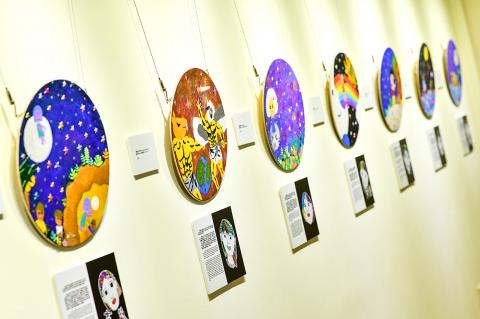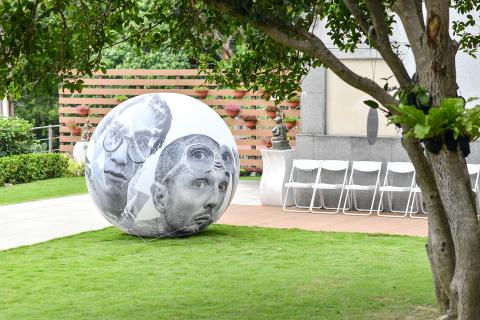Cross-cultural differences, similarities and post-colonial identities are explored through contemporary art in an exhibition put together by Taipei National University of The Arts (TNUA, 國立臺北藝術大學) graduate students, now at the Beitou Public Assembly Hall.
The student curators of “Difference & Identity: Contemporary Cross-Cultural Encounter through Arts” are either enrolled in the international masters’ program in cultural and creative industries and/or at the Graduate Institute of Fine Arts. They have put together the show as part of the work they did for an art exhibition class taught by Chang I-wen (張懿文) and one on intercultural communication taught by Randy Finch.
The artworks are by students at four local elementary or junior-high schools that are partner schools with the “University Social Responsibility” project, which is led by associate professor Lin Ya-tin (林亞婷), as well as established Taiwanese and foreign artists.

Photo courtesy of Anpis Wang
The works range from paintings, photographs and sculptures, to videos and sound installations. The exhibit is divided into three sections, each with a different theme and style.
The focus of the “The Moon” pieces is the common elements found in different cultural mythologies, and features moon-shaped works by elementary and junior-high schools students.
“I Belong: Questions of Identity” and “chaque personne est la seule limite a leur propre identite” (each person is the only limit to their own identity) themed works include pieces by contemporary artists, including Taiwanese multi-media artist Chen Shu-chen (陳淑貞), who has won several national photography and multi-media awards.

Photo courtesy of Anpis Wang
Chen will give a talk about her work and a tour of her “Interracial Marriage Family Portrait” series that is part of the exhibition tomorrow afternoon.
■ “Difference & Identity: Contemporary Cross-Cultural Encounter through Arts,” at Beitou Public Assembly Hall (北投公民會館), 5-7, Zhongshan Rd, Taipei City (台北市中山路5之7號)
■ The exhibition is open through Sunday from 9am to 5pm daily. Admission is free
■ The artist talk and gallery tour by Chen Shu-chen is from 2pm to 4pm tomorrow

One of the biggest sore spots in Taiwan’s historical friendship with the US came in 1979 when US president Jimmy Carter broke off formal diplomatic relations with Taiwan’s Republic of China (ROC) government so that the US could establish relations with the People’s Republic of China (PRC). Taiwan’s derecognition came purely at China’s insistence, and the US took the deal. Retired American diplomat John Tkacik, who for almost decade surrounding that schism, from 1974 to 1982, worked in embassies in Taipei and Beijing and at the Taiwan Desk in Washington DC, recently argued in the Taipei Times that “President Carter’s derecognition

This year will go down in the history books. Taiwan faces enormous turmoil and uncertainty in the coming months. Which political parties are in a good position to handle big changes? All of the main parties are beset with challenges. Taking stock, this column examined the Taiwan People’s Party (TPP) (“Huang Kuo-chang’s choking the life out of the TPP,” May 28, page 12), the Democratic Progressive Party (DPP) (“Challenges amid choppy waters for the DPP,” June 14, page 12) and the Chinese Nationalist Party (KMT) (“KMT struggles to seize opportunities as ‘interesting times’ loom,” June 20, page 11). Times like these can

June 23 to June 29 After capturing the walled city of Hsinchu on June 22, 1895, the Japanese hoped to quickly push south and seize control of Taiwan’s entire west coast — but their advance was stalled for more than a month. Not only did local Hakka fighters continue to cause them headaches, resistance forces even attempted to retake the city three times. “We had planned to occupy Anping (Tainan) and Takao (Kaohsiung) as soon as possible, but ever since we took Hsinchu, nearby bandits proclaiming to be ‘righteous people’ (義民) have been destroying train tracks and electrical cables, and gathering in villages

Dr. Y. Tony Yang, Associate Dean of Health Policy and Population Science at George Washington University, argued last week in a piece for the Taipei Times about former president Ma Ying-jeou (馬英九) leading a student delegation to the People’s Republic of China (PRC) that, “The real question is not whether Ma’s visit helps or hurts Taiwan — it is why Taiwan lacks a sophisticated, multi-track approach to one of the most complex geopolitical relationships in the world” (“Ma’s Visit, DPP’s Blind Spot,” June 18, page 8). Yang contends that the Democratic Progressive Party (DPP) has a blind spot: “By treating any